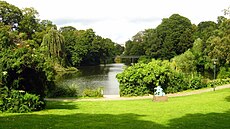Parks and open spaces in Copenhagen

Copenhagen is a green city well endowed with open spaces. It has an extensive and well-distributed system of parks that act as venues for a wide array of events and urban life. As a supplement to the regular parks, there are a number of congenial public gardens and some cemeteries doubling as parks. It is official municipal policy in Copenhagen that all citizens by 2015 must be able to reach a park or beach on foot in less than 15 minutes.[1]
Parks

Some of Copenhagen's newer parks draw from their position by the water.
It is official municipal policy in Copenhagen that all citizens by 2015 must be able to reach a park or beach on foot in less than 15 minutes.[8] In line with this policy, several new parks are under development in areas poor in green spaces.[9][10] One of those recently completed is Superkilen, an innovative park for the ethnic inhabitants of the Nørrebro district of Copenhagen.[11]
Public gardens
Besides the regular parks, a number of gardens open to the general public serve as important green spaces in central Copenhagen. These include:
- The Library Garden (55°40′29″N 12°34′53″E / 55.6746°N 12.5813°E), the garden of the Royal Library on Slotsholmen, located between the library and Christiansborg Palace[12]
- The Glyptoteque Garden (55°40′20″N 12°34′16″E / 55.6721°N 12.5712°E), the small garden behind the Ny Carlsberg Glyptotek
- Grønnegården (55°41′11″N 12°35′37″E / 55.6864°N 12.5935°E), the inner courtyard of the Museum of Art & Design
- The Carlsberg Academy Garden in the Carlsberg District (55°39′52″N 12°32′00″E / 55.6644°N 12.5333°E), one of two historic gardens at the former brewery site. Now open to the public during daytime.
Cemeteries

Characteristic of Copenhagen is that a number of
Greenways
Copenhagen Municipality is developing a system of interconnected green bicycle routes,
Semi-natural areas

Some open spaces on the outskirts of Copenhagen have a more informal and semi-natural character, having originally been countryside areas protected against surrounding urbanisation. They include:
- Amager Common (55°39′0.65″N 12°34′41.78″E / 55.6501806°N 12.5782722°E), is a 223 hectare protected area on Amager.[16]
- Kalvebod Common (55°36′31″N 12°32′07″E / 55.6086°N 12.5354°E), a 2,000-hectare protected area right next to the new business district of Ørestad. Its natural, slightly maintained parkland features a range of ecosystems, from young forests to tidal marshes; some areas are prevented from developing into forests by grazing livestock and game.
- Utterslev Mose (55°43′02″N 12°30′22″E / 55.7173°N 12.5060°E), a 221-hectare area in the northwestern part of Copenhagen. Three lakes with extensive reed beds cover a total of 91 hectares and are surrounded by parkland.[17]
- red and fallow deer.
- Vestskoven (55°41′33″N 12°22′06″E / 55.6925°N 12.3682°E), a 130-hectare forested area located west of Copenhagen, mainly in Albertslund Municipality
- Hareskoven (55°46′13″N 12°24′14″E / 55.7702°N 12.4039°E), a 485-hectare forested area to the northwest of Copenhagen, situated in Furesø and Gladsaxe municipalities
References
- ^ En grøn og blå storby[permanent dead link], Københavns Kommune
- ^ "King's Garden". Slots- og Ejeondomsstyrelsen. Archived from the original on March 29, 2008. Retrieved 2009-01-05.
- ^ "Kongens Have". AOK. Retrieved 2009-01-05.
- ^ "King's Garden". Slots- og Ejeondomsstyrelsen. Archived from the original on March 29, 2008. Retrieved 2009-01-05.
- ^ "Botanisk Have". Carlsberg. Archived from the original on 2016-05-18. Retrieved 2009-01-05.
- ^ "Fælledparken". AOK. Retrieved 2009-01-05.
- ^ "Amager Strandpark". AOK. Retrieved 2009-01-05.
- ^ "En grøn og blå storby". Københavns Kommune. Retrieved 2009-01-05.[permanent dead link]
- ^ "Superkilen by Bjarke Ingels Group". Dezeen. Retrieved 2009-01-05.
- ^ ""1001 Træ", Nordvest". Københavns Kommune. Archived from the original on 2007-04-29. Retrieved 2009-01-05.
- ^ Bonnie Fortune, "So many people lent a hand to give us parklife!", Copenhagen Post, 15 January 2012. Retrieved 16 October 2012.
- ^ Det Kongelige Biblioteks Have Archived 2005-10-27 at archive.today, Slots- og Ejendomsstyrelsen
- ^ "København får mere liv på kirkegårdene". Politiken. Retrieved 2009-01-05.
- ^ "Guide: Gå på opdagelse i de dødes haver". Politiken. Retrieved 2009-01-05.
- ^ Green bicycle routes Archived February 28, 2009, at the Wayback Machine, Københavns Kommune
- ^ "Amager Fælled". naturstyrelsen.dk (in Danish). Retrieved 2020-06-09.
- ^ Utterslec Mose, Dansk Ornitologisk Forening
External links
![]() Media related to Parks in Copenhagen at Wikimedia Commons
Media related to Parks in Copenhagen at Wikimedia Commons
